DID YOU KNOW ABOUT THIS IN WINDOWS? CONNECT TO YOUR ANDROID PHONE
November 8, 2025 / by Marco / Categories : Business, Technology, Windows
Windows has quietly become an excellent companion to your Android phone. Thanks to Microsoft’s Phone Link app (formerly known as Your Phone), your PC can receive your mobile notifications, show your photos and messages, let you take calls, and even control media playback—without you lifting your phone. It’s brilliant for productivity and for keeping your attention on one screen instead of constantly bouncing between devices.
But what if you like the features, yet you don’t want Phone Link taking pride of place on your Start menu? In this guide, we’ll walk through how to remove the Phone Link card from the Start menu, show you how to bring it back again, and, along the way, explore what Phone Link can do, how to set it up properly, and how to customise it so it’s genuinely helpful rather than distracting.
What Is Phone Link, and Why Should You Care?
Phone Link is Microsoft’s bridge between your Windows PC and your Android handset. On many Android devices—especially Samsung Galaxy phones and the Surface Duo—the companion feature is called Link to Windows. Once connected, your PC becomes a command centre for a surprising amount of everyday phone activity: texts, calls, photos, notifications, and, on supported devices, even mirroring and running your mobile apps on your desktop.
If you’ve ever been deep into work and missed a message because your phone was on silent, or you’ve emailed yourself a photo from your phone just to get it onto your PC, you’ll appreciate how much smoother life gets with a proper link in place.

What It Looks Like in the Start Menu
Depending on your Windows version and personalisation settings, you may see a Phone Link panel in your Start menu—often on the right-hand side (in Windows 10’s tile area) or as part of your Start personalisation in Windows 11. This panel can display information pulled directly from your phone—recent photos, messages, or a now playing widget if you’re listening to something. Handy? Absolutely. Necessary to have on your Start menu? That’s up to you. Luckily, it’s easy to toggle on and off.

A Quick Tour of What Phone Link Can Do
Before we dive into Start menu tidying, it’s worth recapping what’s possible when your devices are connected. Many people only discover a fraction of the functionality available.
1) Notifications on Your PC
When configured, Phone Link mirrors your Android notifications to your Windows desktop. That means low-friction awareness: new WhatsApp messages, calendar reminders, and app alerts appear in the notification panel on your PC. You can control which apps are allowed to send notifications through, snooze them, or reply where supported. This keeps you focused while ensuring you don’t miss the truly important stuff.
2) Messages and Calling
Phone Link integrates with your SMS and, on many devices, supports call handling. You can read and reply to texts from your keyboard, which is faster and more comfortable. With Bluetooth set up, you can place and receive calls on your PC, routing audio through your headset or speakers. For those who don’t enjoy juggling a phone mid-call, this is a genuine quality-of-life improvement.
3) Photos at Your Fingertips
One of the most popular features is quick access to your recent photos. If you’ve just snapped a picture on your phone and want to drop it into a PowerPoint slide or an email, you can pull it straight into your app from Phone Link—no manual file transfers or cloud uploads necessary. You can also copy, save, or drag-and-drop images to your desktop or into documents.
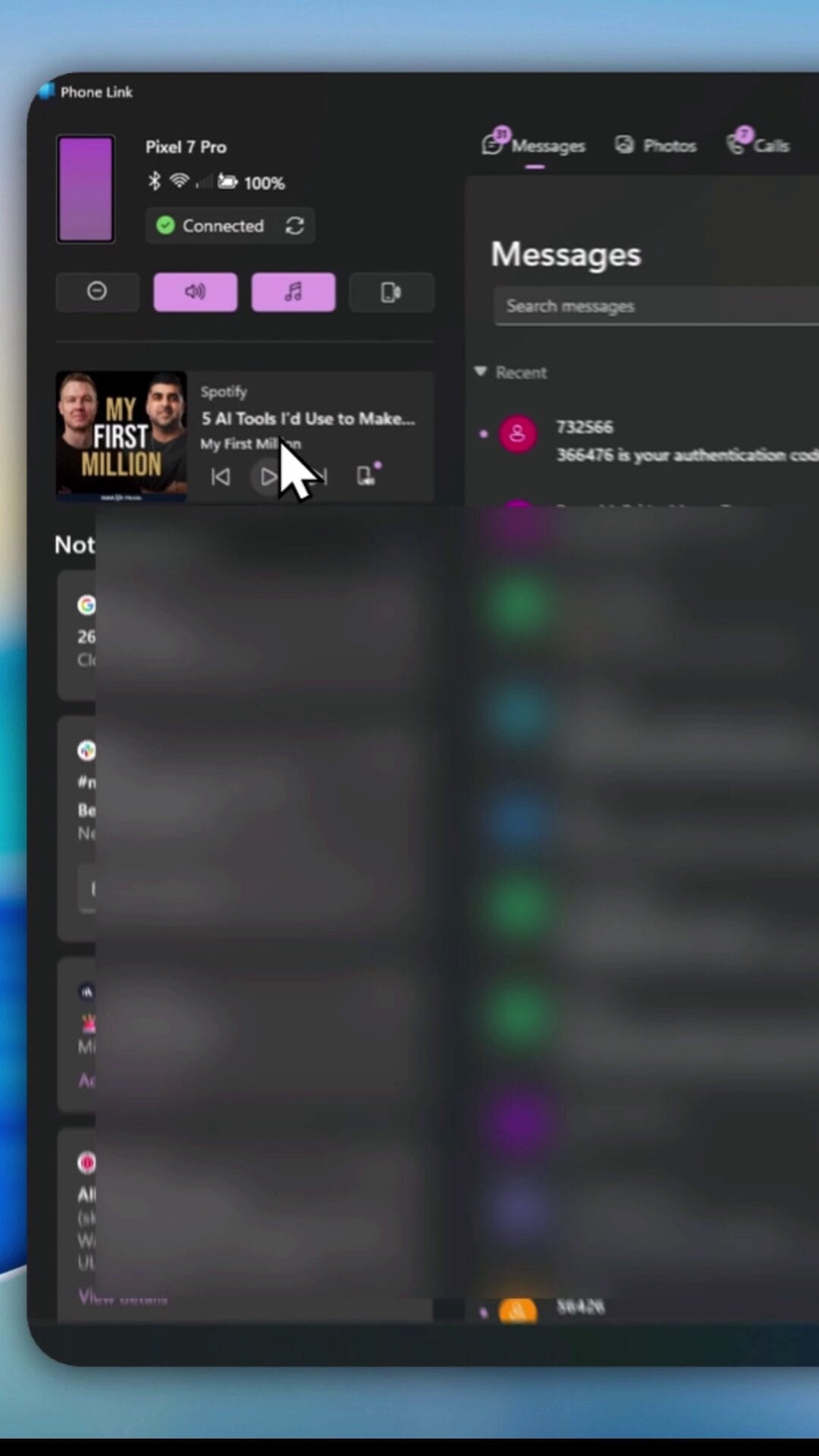
4) Media Controls (Such as Spotify)
If you’re playing music or podcasts on your phone—Spotify is a familiar example—you can often see and control playback from your PC. Tap play or pause, skip a track, or adjust volume without reaching for your phone. It’s a small touch that reduces context switching and adds a seamless feel to your setup.
5) App Mirroring and App Streaming (Supported Devices)
On selected devices (notably many Samsung Galaxy phones and the Surface Duo), Phone Link supports mirroring your phone screen or streaming Android apps in windows on your desktop. That means you can run your favourite mobile apps—banking, messaging, or niche tools—without looking away from your PC monitor. You can also pin frequently used mobile apps to your taskbar like regular desktop apps. This capability varies by device and Android version, but when it’s available, it’s transformative.
6) Cross-Device Copy and Paste
Clipboard syncing is another time-saver. Copy text on one device and paste on the other. Grabbing a code from a two-factor authentication SMS and pasting it into a login page on your PC becomes painless. As always, you can control whether this is enabled and which direction the sync goes.
7) File Transfer and Drag-and-Drop (Device Dependent)
Some phones allow you to drag files directly from your phone gallery or app windows into Windows Explorer, and vice versa. This is particularly helpful for photos, but it also applies to documents and other files, depending on your device’s supported features.
Requirements and Setup: Getting Phone Link Working Properly
If you’ve never tried Phone Link, it’s worth giving it a go. The setup is straightforward, and once connected, everything runs in the background.
What You Need
- A Windows 10 or Windows 11 PC with the Phone Link app installed (it’s included by default on most modern builds).
- An Android phone running Android 7.0 (Nougat) or later. For advanced features like app streaming, a supported device (Samsung Galaxy or Surface Duo) is often required.
- A Microsoft account. You need to sign in on both your PC and your phone.
- Bluetooth (for calls) and a solid Wi‑Fi connection. For best results, connect both devices to the same network.
How to Connect
- On your PC, open the Phone Link app (search for “Phone Link” in Start).
- On your Android phone, install or open the companion app. Many phones have it built in as Link to Windows; otherwise, download Link to Windows from the Play Store.
- Sign in with the same Microsoft account on both devices.
- Follow the prompts to pair via a QR code or sign-in, and grant the requested permissions for notifications, contacts, calls, photos, and background activity.
- Optionally, enable clipboard sync and app streaming if supported.
Once set up, you’ll see your phone model name appear in the Phone Link app, along with tabs for messages, calls, notifications, apps (if available), and photos.
Decluttering the Start Menu: Remove the Phone Link Card
If you’re using Phone Link but don’t want its panel appearing in your Start menu, you can hide it in a couple of clicks. This doesn’t disable Phone Link or disconnect your phone—it simply removes that Start menu area dedicated to your mobile device.
The process is as follows:
- Click the Start button to open your Start menu. You’ll see the Phone Link options on the side (often showing your mobile device and quick actions).

- Click the “More” button associated with that panel, then choose Start settings. This jumps you straight to the personalisation area relevant to Start.

- In Start settings, look for the option labelled “Show mobile device in Start”. Toggle this off. This setting controls whether your linked phone’s panel appears on the Start menu.
- Press the Start button again. You’ll notice the right-hand side Phone Link options have disappeared. Your Start menu is now cleaner.
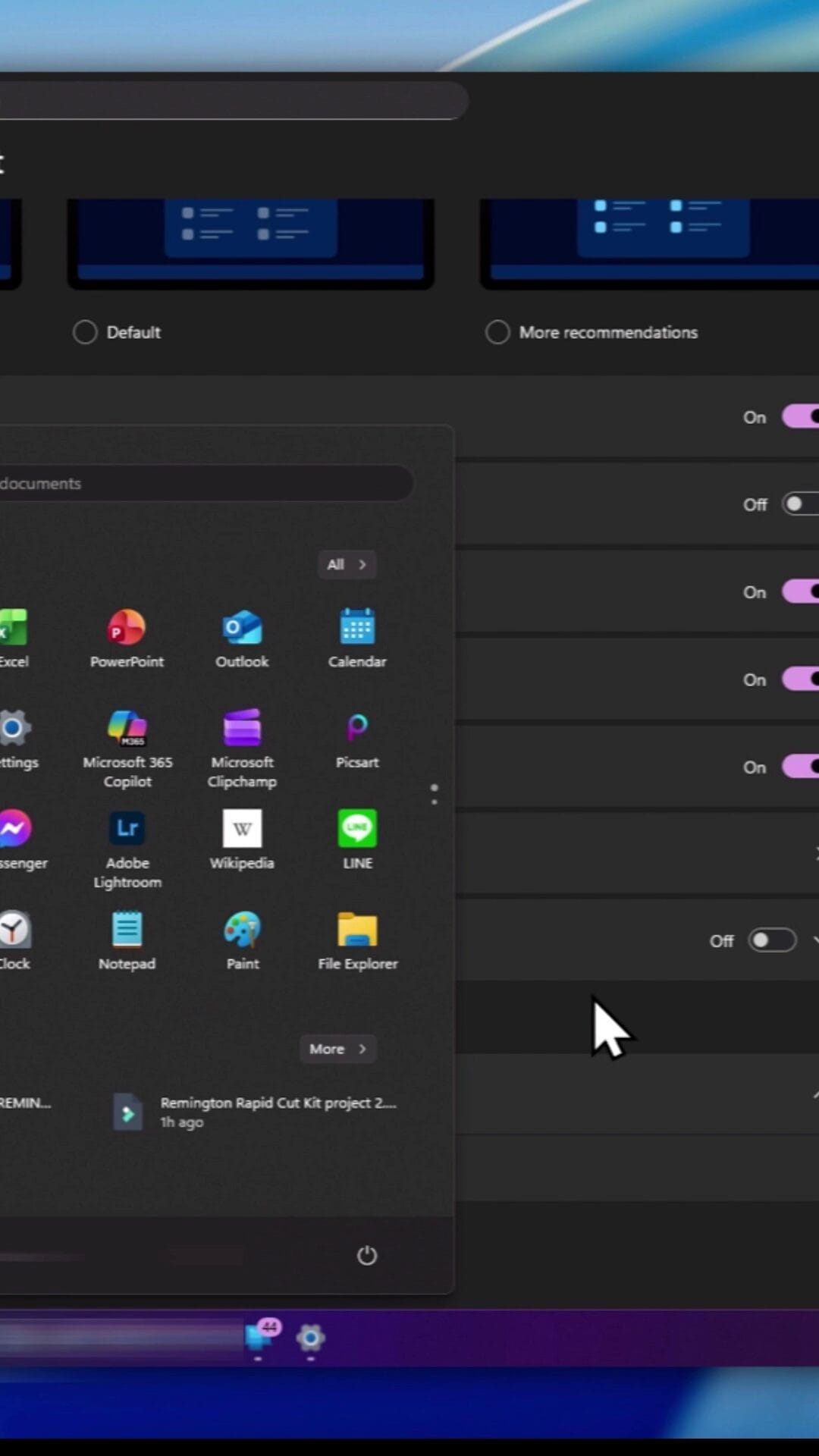
That’s it. You’ve merely hidden the Start menu integration. Phone Link still works: you can open the Phone Link app from your Start menu like any other app to access your messages, photos, notifications, and more. If you ever miss having that quick glance on Start, you can re-enable it just as easily.
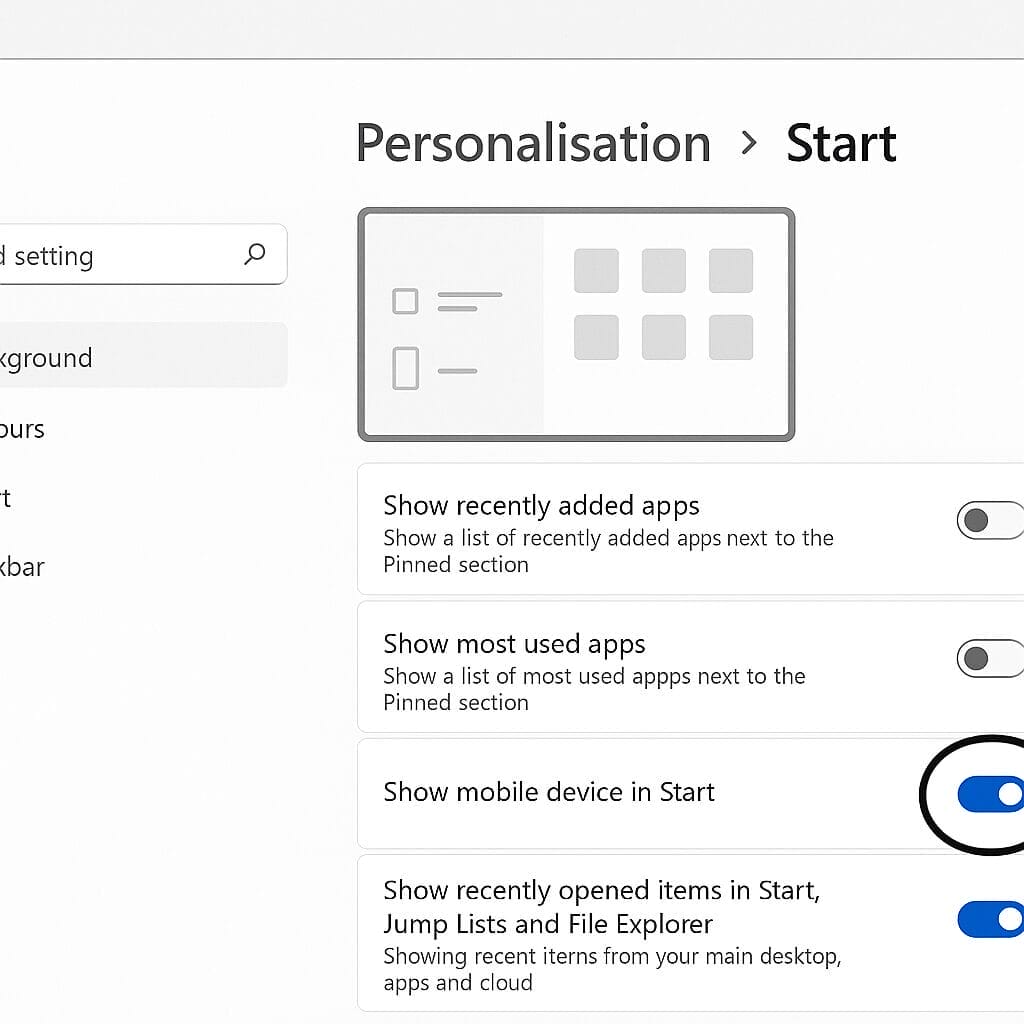
How to Put It Back Again
To restore the Phone Link panel in Start:
- Open Settings (Windows + I) and go to Personalisation > Start.
- Turn on “Show mobile device in Start”.
- Open Start to confirm the Phone Link options have returned.
It’s designed to be flexible. Toggle it on when you want visibility, toggle it off when you prefer minimalism.
Alternative Ways to Tidy Your Start and Taskbar
If your goal is to reduce visual clutter or to focus on a different workflow, consider these additional tweaks:
Unpin Phone Link from Start or Taskbar
- Right-click the Phone Link tile or icon and choose Unpin from Start.
- If it’s on your taskbar, right-click the taskbar icon and select Unpin from taskbar.
This simply removes shortcuts. It won’t affect whether the Start panel appears unless you toggle that specific “Show mobile device in Start” setting.
Control Notification Noise
If you like the panel but not the interruptions, you can shape the notification experience:
- In the Phone Link app on your PC, open Settings and choose which apps on your phone are allowed to forward notifications.
- Use Focus Assist (Windows 10) or Do Not Disturb (Windows 11) to silence notifications during work or meetings.
Manage What Data Is Synced
Under Phone Link settings, disable any areas you don’t need—calls, messages, or clipboard sync—to reduce prompts and resource usage.
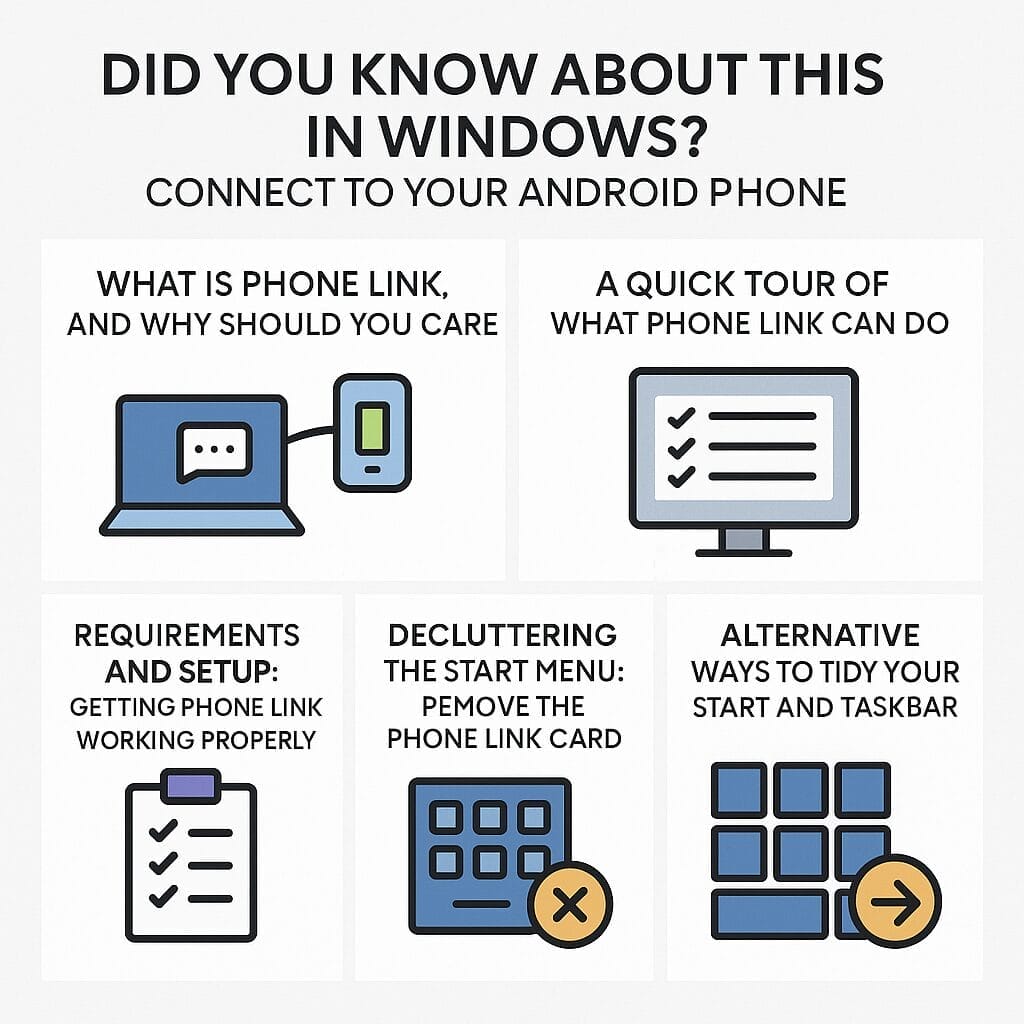
Practical Use Cases: Why Many People Keep Phone Link Enabled
Even if you decide to hide the Start panel, Phone Link itself is worth keeping:
- Busy professionals: Triaging messages on your PC saves time, and you can drag photos into documents instantly.
- Students: Keep on top of two-factor codes and campus alerts without checking your phone mid-lecture.
- Remote workers: Handle calls on your computer’s mic and headset; no need to reach for a handset while sharing your screen.
- Creative teams: Rapidly move reference photos from phone to PC, or control audio playback while editing.
These small efficiencies add up across a day, and they’re even more noticeable if you’re already working from a tidy, focused desktop environment.
Troubleshooting: When the Start Option Isn’t There
If you can’t find the “Show mobile device in Start” toggle or the Start panel doesn’t behave as expected, try the following:
- Update Windows: Make sure you’re on a recent build of Windows 10 or Windows 11. Some Start personalisation features vary by version.
- Update Phone Link: Open the Microsoft Store and check for updates to the Phone Link app.
- Sign Out and Back In: In the Phone Link app, sign out of your Microsoft account on both devices, then reconnect.
- Check Permissions on Android: Ensure notifications, calls, SMS, photos, and background activity permissions are granted to Link to Windows.
- Wi‑Fi and Bluetooth: Confirm Bluetooth is on (for calls), and both devices are on stable Wi‑Fi (ideally the same network).
Still no luck? The option could be intentionally disabled in managed or enterprise environments. If you’re using a work PC, your IT department may control Start personalisation. In that case, speak to your administrator.
Connectivity Tips for a Flawless Experience
Because Phone Link relies on a few different technologies working together—network, Bluetooth, background processes—these tips can help keep it reliable:
- Battery Optimisation: On Android, exempt Link to Windows from aggressive battery optimisation so it can run in the background.
- Do Not Disturb: Remember that DND on your phone can suppress notifications, which in turn affects what appears on your PC.
- Firewall and VPN: If you’re using a strict firewall or corporate VPN, some features may be blocked. Allow the Phone Link app and local network traffic.
- Bluetooth Pairing: Re-pair devices if calls or audio controls stop working. Delete and re-add both sides for a fresh handshake.
- Same Account Everywhere: Check you’re using the same Microsoft account on PC and phone—that’s a common oversight.
Privacy and Security Considerations
Phone Link asks for a number of permissions to deliver its features. It’s sensible to understand what they do and decide what you’re comfortable enabling.
- Notifications: Allows your PC to display the same notifications your phone receives. You can filter which apps mirror alerts.
- Messages: Grants access to SMS so you can read and reply from your PC. Nothing is shared beyond your Microsoft account and the devices you’ve approved.
- Calls: Uses Bluetooth to route audio and dial from your PC. You can disable calling and still use other features.
- Photos and Media: Lets your PC view and copy recent images from your phone. You are not uploading your entire gallery to the cloud unless you explicitly use OneDrive or similar.
- Clipboard: If enabled, your copied content is synced between devices. Disable it if you frequently copy sensitive data and prefer to keep clipboards separate.
You remain in control. Each category can be toggled on or off, and you can revoke permissions from your Android settings at any time. If your PC is shared, consider setting up separate user accounts in Windows and signing into Phone Link only under your own profile.
For Power Users and IT: Deeper Customisation
For most people, the Start menu toggle is more than enough. But if you’re a power user or administrating multiple PCs, you might want deeper control.
Pinning Mobile Apps to the Taskbar
On supported phones, stream an Android app and right-click its window to pin it. This gives you fast one-click access in future and blends your mobile and desktop workflows.
Keyboard Shortcuts and Multi-Window
When using app streaming, many apps respond to standard Windows shortcuts (copy/paste, navigation). You can arrange mobile apps alongside desktop apps in split-view, which is brilliant for referencing content while writing.
Policy-Based Controls (Managed Devices)
In corporate environments, admins may lock down certain Start features for consistency. If users report not seeing the “Show mobile device in Start” toggle, it may be by design. In such cases, provide direct shortcuts to Phone Link or document how to access it via search. Always test policy changes on a pilot group to avoid disrupting productivity.
How the Start Menu Panel Fits Into Your Workflow
Microsoft’s idea with the Start panel is to surface what you need with minimal clicks: recent photos, a quick peek at messages, or the ability to pause what’s playing. If you’re someone who likes dashboards and glanceable info, keeping the Phone Link panel visible may be beneficial. On the other hand, if you’ve carefully curated a minimalist Start, switching it off keeps things tidy while retaining full access to Phone Link as a normal app.
The key is flexibility. Toggle the panel on during busy seasons when you need at-a-glance visibility. Toggle it off when you’re aiming for deep work and want fewer visual elements on Start.

Step-by-Step Recap: Hide or Show Phone Link in Start
Let’s consolidate the process highlighted earlier with the exact wording you’re likely to see in Settings.
To Hide the Panel
- Open Start and locate the Phone Link panel on the right-hand side.
- Click the More button, then select Start settings.
- Find “Show mobile device in Start” and switch it off.
- Open Start again to confirm the panel is gone.
To Show the Panel Again
- Open Settings > Personalisation > Start.
- Toggle on “Show mobile device in Start”.
- Open Start to verify it’s back.

Final Thoughts: Try Phone Link, Make It Yours
Phone Link is one of those features that quietly reshapes your daily computer use. It reduces friction, keeps you informed, and brings your phone and PC into a single, cohesive workspace. Whether you’re controlling Spotify from your keyboard, dragging photos directly into a document, or quickly replying to a text, you’ll likely find it saves time and mental overhead.
And if you’re not keen on seeing it in your Start menu, that’s perfectly fine. Now you know how to hide—and restore—the Phone Link panel with a quick visit to Start settings. The beauty is that you have options. Try Phone Link if you haven’t already; use the parts that help, and turn off what doesn’t. It’s a powerful tool when tailored to your preferences, and it’s built into the Windows experience you already use every day.

Give it a go, see how you get on, and tweak as needed. With a minute or two of setup and a couple of toggles, you can craft a Windows and Android duo that genuinely works the way you do.
OTHER ARTICLES YOU MAY LIKE

DID YOU KNOW ABOUT THIS IN WINDOWS? CONNECT TO YOUR ANDROID PHONE
Windows has quietly become an excellent companion to your Android phone. Thanks to Microsoft’s Phone Link app (formerly known as Your Phone), your PC can receive your mobile notifications, show your photos and messages, let you take calls, and even control media playback—without you lifting your phone. It’s brilliant for productivity and for keeping your […]
read more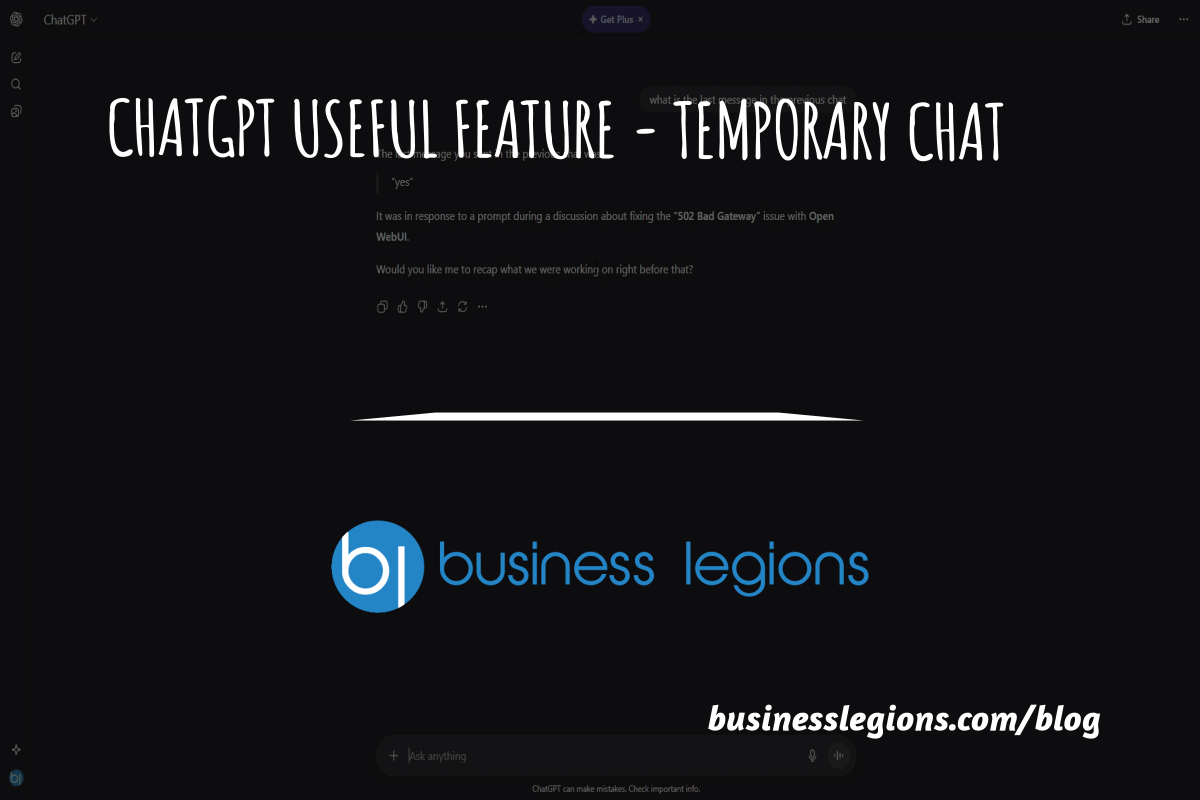
CHATGPT USEFUL FEATURE: TEMPORARY CHAT
Everyday use of ChatGPT naturally trains you to think in threads. You ask a question, you get an answer, you refine the prompt, and the conversation accretes context. It’s one of the reasons ChatGPT feels more like a companion than a search box: it remembers what you said so it can respond appropriately next time […]
read more
